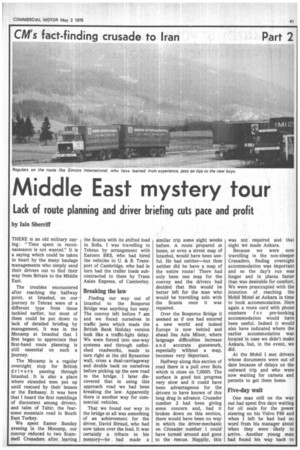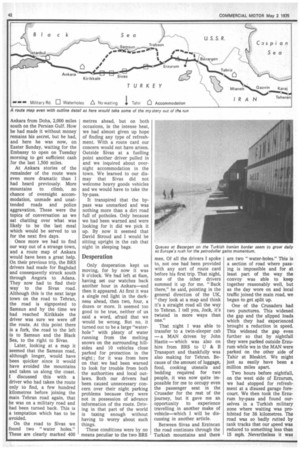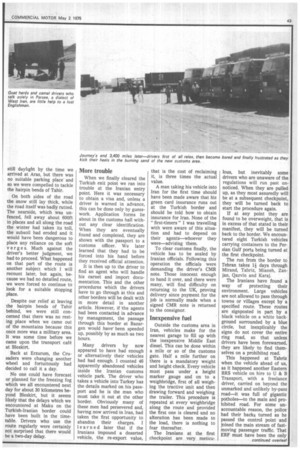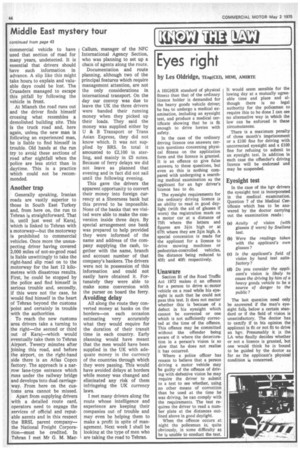Middle East mystery tour
Page 43

Page 44

Page 45

Page 46

If you've noticed an error in this article please click here to report it so we can fix it.
Lack of route planning and driver briefing cuts pace and profit
by lain Sherriff
THERE is an old military saying: "Time spent in reconnaissance is not wasted." It is a saying which could be taken to heart by the many haulage managements who simply send their drivers out to find their way from Britain to the Middle East.
The troubles encountered after reaching the halfway point, at Istanbul, on our journey to Tehran were of a different type from those tackled earlier, but most of them could be put down to lack of detailed briefing by management. It was in the Mocamp at Istanbul that I first began to appreciate that first-hand route planning is still essential on such a journey.
The Mocamp is a regular overnight stop for British drivers passing through Istanbul. It is also a place where stranded men put up until rescued by their bosses or the Embassy. It was here that I heard the first rumblings of discontent among drivers, and tales of Tahir, the fearsome mountain road in South East Turkey.
We spent Easter Sunday evening in the Mocamp, our convoy reduced to two Scammell Crusaders after leaving the Scania with its shifted load in Sofia. I was travelling to Tehran by arrangement with Eastern BRS, who had hired the vehicles to U. & B. Transport of Cambridge, who had in turn had the trailer loads subcontracted to them by Trans Asian Express, of Camberley.
Breaking the law
Finding our way out of Istanbul to the Bosporus Bridge was anything but easy. The convoy left before 7 am and we found ourselves in traffic jams which made the British Bank Holiday version look like a traffic-light delay. We were forced into one-way systems and through unfinished roadworks, made to turn right at the old Byzantine wall, cross a dual-carriageway and double back on ourselves before picking up the new road to the bridge. I later discovered that in using this approach road we had been breaking the law. Apparently there is another way for commercial vehicles.
That we found our way to the bridge at all was something of an achievement for the driver, David Stroud, who had now taken over the lead. It was certainly a tribute to his memory—he had made a similar trip some eight weeks before. A route prepared at home, or even a street map of Istanbul, would have been useful. He had neither—but then neither did he have a map of the entire route! There had only been one map for the convoy and the drivers had decided that this would be better left for the man who would be travelling solo with the Scania once it was repaired.
Over the Bosporus Bridge it seemed as if one had entered a new world and indeed Europe is now behind and ahead lies Asia Minor, where language difficulties increase a n d accurate guesswork, especially without a map, becomes very important.
Halfway along this section of road there is a pull over Bolu which is close on 7,000ft. The surface is good but progress very slow and it could have been advantageous for the drivers to have known of this long drag in advance. Crusader number 2 had been giving some concern and, had it broken down on this section, there would have been no way in which the driver-mechanic on Crusader number 1 could have turned around and gone to the rescue. Happily, this was not required and that night we made Ankara.
Because we were now travelling in the non-sleeper Crusaders, finding overnight accommodation was important and so the day's run was longer and in places faster than was desirable for comfort. We were preoccupied with the intention of reaching the Mobil Motel at Ankara in time to book accommodation. Here again a route card with phone numbers f o r pre-booking accommodation would have been useful. Indeed it would also have indicated where the earlier accommodation was located in case we didn't make Ankara, but, in the event, we did.
At the Mobil I met drivers whose documents were out of date because of delays on the outward trip and Who were now waiting for carnets and permits to get them home.
Five-day wait
One man still on the way out had spent five days waiting for oil seals for the power steering on his Volvo F88 and when I left he had had no word from his manager about when they were likely to arrive. Another young man had found his way back to Ankara from Doha, 2,000 miles south on the Persian Gulf. How he had made it without money remains his secret, but he had, and here he was now, on Easter Sunday, waiting for the Embassy to open on Tuesday morning to get sufficient cash for the last 1,500 miles.
At Ankara stories of the remainder of the route were even more dramatic than I had heard previously. More mountains to climb, no chance of overnight accommodation, unmade and unattended roads and police aggravation. These were the topics of conversation as we sat chatting over what was likely to be the last meal which would be served to us for the next five days.
Once more we had to find our way out of a strange town, and a route map of Ankara would have been a great help. On their previous trip, the BRS drivers had made for Baghdad and consequently struck south through Angora to Adana. They now had to find their way to the Sivas road. Although this is the next large town on the road to Tehran, the road is signposted to Samsun and by the time we had reached Kirikkale the driver was sure we were off the route. At this point there is a fork, the road to the left is to Samsun and the Black Sea, to the right to Sivas.
Later, looking at a map it seemed that the Samsun road, although longer, would have been quicker since it would have avoided the mountains and taken us along the coast. I discussed this with a driver who had taken the route only to find, a few hundred kilometres before joining the main Tehran road again, that he was on a military road and had been turned back. This is a temptation which has to be avoided.
On the road to Sivas we found two "water holes." These are clearly marked 400 metres ahead, but on both occasions, in the intense heat, we had almost given up hope of finding any type of refreshment. With a route card our concern would not have arisen. Outside Sivas at a fuelling point another driver pulled in and we inquired about overnight accommodation in the town, We learned to our dismay that Sivas did not welcome heavy goods vehicles and we would have to take the by-pass.
It transpired that the bypass was unmarked and was nothing more than a dirt road full of potholes. Only because we had been warned and were looking for it did we pick it up. By now it seemed that David Stroud and I would be sitting upright in the cab that night in sleeping bags.
Desperation
Only desperation kept us moving, for by now it was 9 o'clock. We had left at 6am, having set our watches back another hour in Ankara—and then it appeared. At first it was a single red light in the darkness ahead, then two, four, a dozen or more. It seemed too good to be true, neither of us said a word, afraid that we would be wrong. But no, it turned out to be a large "waterhole" with plenty of water running from the melting snows on the surrounding hillsides and 10 vehicles close parked for protection in the night ; for it was from here on that we had been warned to look for trouble from both the authorities and local outlaws. Both our drivers had been caused unnecessary concern over their night parking problems because they were not in possession of advance information of the route. Driving in that part of the world is taxing enough without having to worry about such things.
These conditions were by no means peculiar to the two BRS men. Of all the drivers I spoke to, not one had been provided with any sort of route card before his first trip. That night, one of the other drivers summed it up for me. "Back there," he said, pointing in the general direction of the UK, " they look at a map and think it's a straight road all the way to Tehran. I tell you, Jock, it's twisted in more ways than one."
That night I was able to transfer to a twin-sleeper cab — a MAN driven by John Hastie — which was also on hire from BRS to U & B Transport and thankfully was also making for Tehran. Because of the amount of luggage, food, cooking utensils and bedding required for two people, it was now quite impossible for me to occupy even the passenger seat in the Crusader for the rest of the journey, but it gave me an opportunity to experience travelling in another make of vehicle—which I will be discussing in another article.
Between Sivas and Erzincan the road continues through the Turkish mountains and there are two " water-holes." This is a section of road where passing is impossible and for at least part of the way the convoy was able to keep together reasonably well, but as the day wore on and local traffic joined the main road, we began to get split up.
One of the Crusaders had two punctures. This widened the gap and the slipped loads which they had experienced brought a reduction in speed. This widened the gap even further so that by nightfall they were parked outside Erzurum while we in the MAN were parked on the other side of Tahir at Bleskirt. We might just as easily have been a million miles apart.
Two hours before nightfall, on the west side of Erzurum, we had stopped for refreshment at a disused garage forecourt. We then took the Erzurum by-pass and found ourselves in a Turkish military zone where waiting was prohibited for 38 kilometres. The road was so badly rutted by tank tracks that our speed was reduced to something less than 15 mph. Nevertheless it was still daylight by the time we arrived at Aras, but there was no suitable parking place and so we were compelled to tackle the hairpin bends of Tahir.
On both sides of the road the snow still lay thick, while the road itself was badly rutted. The nearside, which was unfenced, fell away about 600ft in places and all along the road the winter had taken its toll, the subsoil had eroded and it would have been dangerous to place any reliance on the soft verge s. Much against the driver's better judgment, we had to proceed. What happened on that part of the route is another subject which I will recount later, but again, because we had no detailed route, we were forced to continue to look for a suitable stopping place.
Despite our relief at leaving the hairpin bends of Tahir behind, we were still concerned that there was no resting place when we came out of the mountains because this once more was a military area. It was some time before we came upon the transport cafe at Bleskirt.
Back at Erzurum, the Crusaders were changing another wheel and fortuitously had decided to call it a day.
No one could have forecast or planned for the freezing fog which we all encountered next day for about 30 kilometres beyond Bleskirt, but it seems likely that the delays which we encountered at Maku on the Turkish-Iranian border could have been built in the timetable. Drivers who use the route regularly were certainly not surprised that there would be a two-day delay.
More trouble
When we finally cleared the Turkish exit point we ran into trouble at the Iranian entry point. Here it was necessary to obtain a visa and, unless a driver is warned in advance, this can be done only by guesswork. Application forms lie about in the customs hall without any clear identification. When they are eventually found and completed, they are shown with the passport to a customs officer. We later learned that they had to be forced into his hand before they received official attention.
It is then up to the driver to find an agent who will handle his carnet and import documentation. This and the other procedures which the drivers have to go through at this and other borders will be dealt with in more detail in another article. However, if the agents had been contacted in advance by management, the passage through this border at Bazargen would have been speeded up, possibly by as much as two hours.
Many drivers by now appeared to have had enough or alternatively their vehicles had had enough. I counted 46 apparently abandoned vehicles inside the Iranian customs vehicle park. The driver who takes a vehicle into Turkey has the details marked on his passport and he is the man who must take it out at the other border. Obviously many of these men had persevered and, having now arrived in Iran, had taken the first opportunity to abandon their charges. I I earned later that if the Iranians impound a deserted vehicle, the re-export value, that is the cost of reclaiming it, is three times the actual value.
A man taking his vehicle into Iran for the first time should have been made aware that his green card insurance runs out at the Turkish border and should be told how to obtain insurance for Iran. None of the " first-timers " I was travelling with were aware of this situation and had to depend on their agents—whoever they were—advising them.
To clear customs finally, the vehicle has to be sealed by Iranian officials. Following this operation the officials were demanding the driver's CMR note. Those innocent enough to hand it over, and there were many, will find difficulty on returning to the UK, proving delivery since payment for the job is normally made when a signed CMR note is returned to the consignor.
Inexpensive fuel
Outside the customs area in Iran, vehicles make for the nearest garage to fill up with the inexpensive Middle East diesel. This can be done within a mile or so of the customs gate. Half a mile further on there is a mandatory weight and height check. Every vehicle must pass under a height marker gauge and on to a weighbridge, first of all weighing the tractive unit and then drawing forward and weighing the trailer. This procedure is repeated at every weighbridge along the route and provided the first one is cleared and no alteration has been made to the load, there is nothing to fear thereafter.
The Iranians at the first checkpoint are very meticu bus, but inevitably some drivers who are unaware of the regulations will run past unnoticed. When they are pulled up, as they most assuredly will be at a subsequent checkpoint, they will be turned back to start the procedure again.
If at any point they are found to be overweight, that is in excess of that stated in their manifest, they will be turned back to the border. We encountered eight Turkish vehicles carrying containers to the Persian Gulf ports being turned at the first checkpoint.
The run from the border to Tehran takes 14 days through Mirand, Tabriz, Mianeh, Zanjan, Qazvin and Karaj.
The Iranians have found a way of protecting their environment. Large vehicles are not allowed to pass through towns or villages except by a specified route. These routes are signposted in part by a black vehicle on a white background surrounded by a blue circle, but inexplicably the signs do not cover the entire ring road, so that unless drivers have been forewarned, they are likely to find themselves on a prohibited road.
This happened at Tabriz when the vehicle ahead of us, as it happened another Eastern BRS vehicle on hire to U & B Transport, with a freelance driver, carried on beyond the unmarked and unlikely by-pass road—it was full of gigantic potholes—to the main and prohibited road. For some un accountable reason, the police had their backs turned as he passed the control point and joined the main stream of fastmoving passenger traffic. That ERF must have been the only commercial vehicle to have used that section of road for many years, undetected. It is essential that drivers should have such information in advance. A slip like this might take hours to explain and valuable days could be lost. The Crusaders managed to escape this pitfall by following the vehicle in front.
At Mianeh the road runs out and the driver finds himself crossing what resembles a demolished building site. This is the truck road and, here again, unless the new man is following an experienced man, he is liable to find himself in trouble. Old hands at the run try to avoid these sections of road after nightfall when the police are less strict than in daytime. This is a practice which could not be recommended.
Another trap
Generally speaking, Iranian roads are vastly superior to those in South East Turkey and, from here on, the run to Tehran is straightforward. That is, until just west of Karaj, which is linked to Tehran with a motorway—but the motorway is prohibited to commercial vehicles. Once more the unsuspecting driver having covered 2,000 miles of not-so-good road is liable unwittingly to take the right-hand slip road on to the motorway for the last 12 kilometres with disastrous results. First, he could be stopped by the police and find himself in serious trouble and, secondly, if this were not the case, he would find himself in the heart of Tehran beyond the customs point and certainly in trouble with the authorities.
To reach the new customs area drivers take a turning to the right—the second or third out of Karaj—which would eventually take them to Tehran Airport. Twenty minutes after joining this road, and before the airport, on the right-hand side there is an Atlas Copco factory. The approach is a narrow lane-type entrance which runs under the railway bridge and develops into dual carriageway. From here on the customs area cannot be missed.
Apart from supplying drivers with a detailed route card, operators need to engage the services of official and reputable agents and in this respect the BRSL parent company— the National Freight Corporation—must be credited. In Tehran I met Mr G. M. Mac Callum, manager of the NFC International Agency Section, who was planning to set up a chain of agents along the route.
Documentation and route planning, although two of the principal features which require management attention, are not the only considerations in international transport. On the day our convoy was due to leave the UK the three drivers were handed their running money when they picked up their loads. They said the money was supplied either by U & B Transport or Trans Asian Express, they did not know which. It was not supplied by BRS. In total it amounted to £2,100 in sterling, and mainly in £5 notes. Because of ferry delays we did not leave as planned that evening and in fact did not sail until the following evening.
This gave the drivers the apparent opportunity to convert their money into foreign currency at a Sheerness bank but this proved to be impossible. None of the banks that we visited were able to make the conversion inside three days. By special arrangement one bank was prepared to help provided they were informed of the name and address of the company supplying the cash, together with the name, branch and account number of that company's bankers. The drivers were not in possession of this information and could not easily have obtained it. Fortunately they were able to make some conversion with the purser on board the ferry.
Avoiding delay
All along the route they converted money at banks on the borders—on each occasion estimating very accurately what they would require for the duration of their transit time in each country. Early planning would have meant that the men would have been supplied in the UK with adequate money in the currency of the countries through which they were passing. This would have avoided delays at borders while money was changed and eliminated any risk of them infringeing the UK currency laws.
I met many drivers along the route whose intelligence and experience are keeping their companies out of trouble and may even be helping them to make a profit in spite of management. Next week I shall be looking at the type of men who are taking the road to Tehran.
























































































































